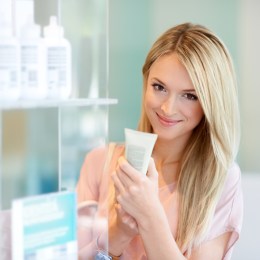Just about anything that can go wrong with the skin will go wrong if its protective barrier springs leaks. Jenni Gilbert talks to the experts.
Extreme dryness and dehydration, pronounced lines or wrinkles, redness and inflammation, acne, rosacea and congestion, eczema or dermatitis, pigmentation, ‘sensitive’ skin, dull and crepey complexions … where do we stop?
Treating these and other skin conditions is likely to be the bread and butter of your business as a dermal therapist, whether in salon, spa or clinic.
While they are diverse issues, there is more than likely a common thread as to their cause, or at least what is exacerbating a client’s systemic issue. It’s the skin’s protective pH mantle – or, rather, what happens if it is out of balance.
 This mantle is a very fine, slightly acidic film on the surface of the skin formed by sebaceous and eccrine sweat gland secretions. It acts as a barrier to potential contaminants (primarily alkaline in nature) that might penetrate the skin. The moderate acidity helps to neutralise these contaminants’ potentially devastating chemical effects.
This mantle is a very fine, slightly acidic film on the surface of the skin formed by sebaceous and eccrine sweat gland secretions. It acts as a barrier to potential contaminants (primarily alkaline in nature) that might penetrate the skin. The moderate acidity helps to neutralise these contaminants’ potentially devastating chemical effects.
The normal acid mantle for skin (and hair) ranges between 4.5 and 5.5. Once the pH exceeds 6.5, bacterial invasion increases dramatically, the skin is weakened and becomes vulnerable to a variety of skin disorders flaring. At the very least, skin can become very dry and dehydrated, even reddened and flaky, making it more prone to lines and wrinkles and generally contributing to an aged appearance.
The hallmark of young and youthful-looking skin is the radiance that comes with optimum hydration. So how do you determine if a compromised acid mantle is a contributor factor to – or, indeed, the cause of – a client’s skin problems?
‘I spend the first consultation asking a lot of questions,’ says leading Sydney dermal beauty therapist Dee Davies. ‘In the modern world there are so many varieties of skin products.
‘The average clients I see are shopping on the net, so they really don’t know what they are purchasing. Many of the products they have bought are overloaded with active ingredients and they didn’t know how to use them – or whether they should have been using them at all.
‘This makes any therapist’s job hard when skins are so sad – drained of all moisture, clogged, red and just worn out – from jumping from one product range to the next.
‘I generally take everything off them and go back to basics. However, there are cases where it’s obvious that they need to see a doctor before starting on any skin repair program. The issue may need medical intervention before results can be achieved, such as with acne.’
CAUSES OF PH IMBALANCE
‘Factors such as hormones, stress, certain health conditions that alter the body’s chemistry, medications and environmental aggressors like UV exposure can all disturb the pH balance,’ says Matoyla Kollaras, director of Skin Factors, distributors in Australia of Christina Cosmeceuticals and Ahava Dead Sea salt skincare.
‘However, the major culprit is the use of soap, lotions and other skin care products that have not been formulated with skin- friendly pH levels.
‘Cleansers are by far the worst offenders, especially those with a strong detergent action. Many products on the commercial market contain ingredients such as sodium laurel sulfate, which strip the acid mantle.
‘The pH level of most cleansers is slightly higher than 5.5, so the cleanser can break down dirt and oil on the skin. However, some – especially bar soap – typically have a pH level of 9 to 12, which is far too high, wearing away at the skin’s acid mantle.
‘Excessive cleansing is another factor in breaking down the acid mantle, as is over- exfoliating. When skin pH levels move outside the normal range for long periods of time, certain skin conditions like dermatitis and infection can develop. High alkaline pH levels can leave the skin vulnerable to bacteria and conditions such as Staphylococcus can develop and acne and rosacea will worsen.’
Another key contributor is ageing. ‘As we age the pH of our skin also increases, resulting in a decrease in skin immunity and an increase in sensitivities,’ says Matoyla. ‘Between 70- 85 percent of the elderly suffer from skin problems and diseases as a direct result of elevated pH. Thus increased awareness of using pH-friendly products in this age bracket is very important.’
It takes approximately 14 hours for the body to restore the acid mantle, according to Shelley Peterson, Babor Australia national trainer. Considering most people cleanse within this time frame – perhaps twice or three times – the skin’s acid mantle does not have a chance to repair. Therefore the likelihood of skin problems occurring is high. Educate your clients not to over-cleanse as well as encouraging them to use the right products for their skin.
GIVE YOUR CLIENTS THE ACID TEST
There are three fundamental tips to help your clients restore a compromised acid mantle and maintain results with proper home care, says Tamara Eacott, Director of Green Living Cosmetics, distributors in Australia of Eminence Organics:
- Educate them about the best cleanser for their skin type and how skin should feel after cleansing. ‘Squeaky’ is definitely not it. pH is first and foremost affected by how much or how little the cleanser degreases the skin’s surface.
- pH balancing with a gentle acid-based toner (again, the best for their skin type) after cleansing quickly rebalances the alkaline environment a cleanser creates.
- When using products containing enzymes, AHAs and BHAs to speed up cell turnover (hence promote clearer, smoother, younger-looking skin) they should know if the products are self-neutralising on removal. If not, they need to stop the activity and rebalance the pH level of the skin prior to the next step in a skincare routine. This of course applies to professional treatments, too. And it’s important not to overdo the use of these formulations.
SENSITIVE OR SENSITISED?
With true sensitive skin there is often a genetic predisposition and a deficiency in the proteins of the skin barrier. There may be an association with respiratory disorders such as asthma, chronic rhinitis and chronic and more severe hay fever.
The key here is that there is always a long history of skin sensitivity (often having started in childhood), and chronic manifestations such as eczema ans dermatitis.
Rosacea is a sensitive skin issue, with clients having a skin behavioural history of flushing and blushing. Medical conditions like lupus and other auto-immune disorders, diabetes, hormone alterations and medications such as steroids can increase skin sensitivity.
However, many people present with what they believe is ‘sensitive’ skin when in fact it has been sensitised by the use of inappropriate products or too-harsh handling, as well as environmental and lifestyle factors.
A study published in 2002 in the International Journal of Dermatology found that ‘most products recommended for sensitive skin have a considerable irritation effect, which is related to the pH of the product.’ There has also been as disturbing increase in skin allergies due to new- generation preservatives in skin and cosmetic products that are causing the sensitivity and sensitising of skin.
It is important to look for proven active ingredients, technological skincare advancements and a company that intensively focuses on its research and development and is minimal in its use of preservatives.
Dermatologists say there has been a surge in allergic reactions, including facial swelling, itching, hives and redness, caused by exposure to the preservatives,’ says Dr John McFadden, consultant dermatologist at St Thomas’ Hospital in London. ‘We are in the midst of an outbreak of allergy which we have not seen before in terms of scale in our lifetime.’
Cues for therapists to get to the core of the problem:
- Check the products your clients are using, or what products they felt triggered sensitivity.
- Are clients over-cleansing and/or exfoliating? What products are they using?
- Discourage use of products that contain high levels of essential oils, alcohol and solvents. These are known sensitising agents. In some cases you will find SPF is a culprit.



